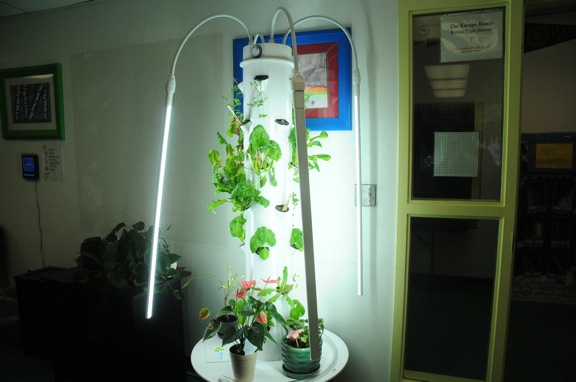SAVOR THE SEASON: LPES highlights healthy living with hydroponic gardens

Hydroponic garden at the Lake Placid Elementary School (News photo — Elizabeth Izzo)
LAKE PLACID – The Lake Placid Elementary School is putting a spotlight on healthy eating and sustainable living with an expanded gardening initiative.
Three vertical hydroponic gardens were installed at the school last month.
The Tower Garden systems, when lit, look like something out of the space age. They’re nearly 6 feet tall and made from a bright white plastic. Thin strips of light sprout from the top and droop down, surrounding a cylindrical stem. At 2 feet wide, they take up a relatively small amount of space in the school’s third-grade class, main office and cafeteria – but school officials hope they’ll have a big impact on students.
The idea to purchase the vertical gardens came from LPES Principal Sonja Franklin, who has one of them at home.
“I thought this would be really cool for the school to have this,” she said.
The fruits of students’ labor have already been incorporated into the school’s lunch menu.
Green lettuce, seen sprouting from small cups that jut from a white cylindrical tower, is used for salads, which the school offers students every day. Parsley leaves just beginning to grow will soon be scattered throughout pasta dishes. Swiss chard will be served up simply, pan-fried. And loose clusters of basil, once ready to harvest, will be used for some sort of watermelon-basil dessert, Franklin said.
Third-grade teacher Patricia Damp said her students got to pick some of the vegetables from the vertical tower in her classroom.
They asked for snap peas, which the students often eat as snacks, and they’re also growing tomatoes, eggplants and other crops.
“You can really plant anything,” Franklin said.
A number of studies show that farm-to-school programs, including in-school gardens, affect students’ willingness to eat fruits and vegetables.
A 2010 University of Newcastle report, for example, looked specifically at school gardens and their impact on students’ knowledge of vegetables, willingness to try them and how good students believed the vegetables taste.
That report found school gardens had the potential to positively impact all of the above, but “more comprehensive strategies (were) required to increase vegetable intake.”
The Centers for Disease Control say that schools are on the front lines when it comes to teaching children how to eat healthy. With most students in school for six hours each day, they consume “as much as half of their daily calories at school,” according to the CDC. “Kids who eat healthy food at school learn better lifelong eating habits and are readier to learn.”
Franklin said she hopes the indoor gardening systems at the school will help students learn about responsibility, technology and sustainable living.
Students are responsible for watering the plants on a rotating schedule. Those in the 4-H and the Environmental Club mostly take care of them, as well as the school’s outdoor garden. In the summertime, summer school students keep the gardens going.
“Having these gardens allows students to learn about farming and the growing cycle from seed to harvest,” Franklin said. “I think they learn a lot from it. The idea of hydroponic gardening is completely new for them.”
Franklin said that most people were taught that to garden you need three things: Soil, water and sun. But these gardens only have one of those things. There’s no soil, and a special “grow light” on a 14-hour timer shines on the plants at night.
“It’s a year-round summer season,” she said. “Having this here allows them to better understand the technology, which allows more options in their futures.”
Franklin said she hopes the experience will show students that, despite the short North Country growing season, healthy eating is also possible during the colder months.
“Fresh foods are out there and available year-round,” she said. “No matter where you live, it’s possible to live sustainably.”






